


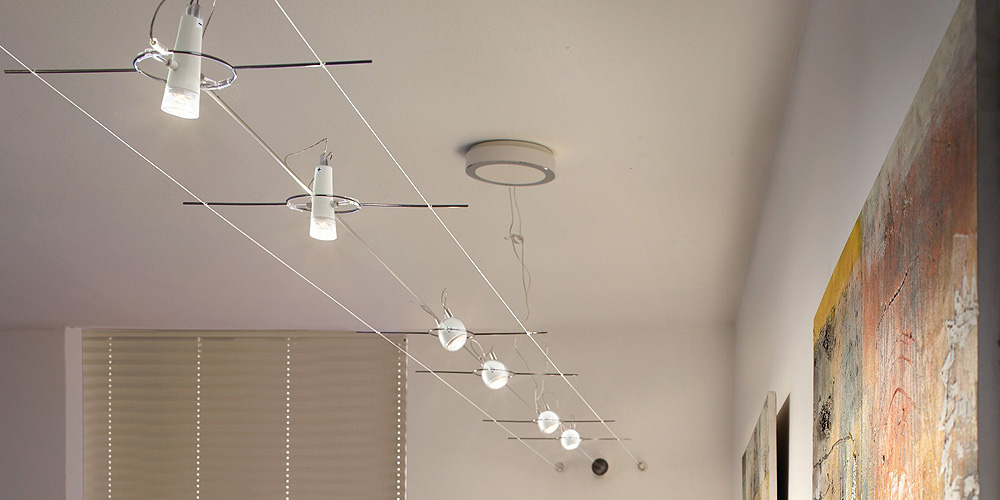
Track lighting refers to a method of lighting where individual fixtures are fixed along one continuous track apparatus. This type of lighting is defined by its concealed conductor, and includes individual spotlights attached to a mounted track. A current runs through the track, allowing flexible positioning of each fixture. Track lighting offers effective accent, task, and ambient lighting, and these types of fixtures may be mounted along ceilings (either vaulted or standard height), walls, beams, rafters, or joists.
Track lighting systems feature two principal components: the rail and track fixtures. Voltage specification and wiring of the system is also a crucial component of any track lighting system. Connectors are used to extend and create a customized shape or look for track lighting systems, while standoffs serve to suspend any rail system. The rail, also known as the bar, houses electrical conductors. Systems may contain more than one conductor, which enables independent control of different fittings in the same track. To define which lights will correspond to each fitting, the tab of each connector should be placed to one side or the other while connecting it to the track. Typical systems use line voltage traveling through the track. This contrasts with non-track systems, where electricity is wired to individual light positions. Track fixtures refers to the units attached to the rail used for housing individual light bulbs.
The three original track lighting tracks, otherwise known as rails, are the H system, J system, and L system. Each track is a standard, specific size, and is compatible with any track lighting system of that same type. Track types also include two-circuit track systems, Monorail track systems, and Cable track systems.
Track fixtures include track heads and track pendants. Typical track systems include three to six fixtures, generally placed evenly along the track. These fixtures extrude from the body of the rail, and house individual light bulbs. Track fixtures are typically adjustable, making it possible to direct the path of light emitting from each light bulb.
Most track lighting systems are line voltage and include a concealed conductor. Line voltage track lighting offers a solution in cases where a long run is required. Track lighting can use line voltage (defined as 120V) without the risk of incurring voltage drop, while a concealed conductor eliminates the risk of an electric shock with track lighting.
Some track lighting systems are available with low voltage, defined as 10V, 12V or 24V. These systems may feature a track made of three strips, two metal strips and one insulating strip, with fixtures that clamp into the track, as well as a transformer for converting high voltage currents to low voltage. Low voltage tracks are a modern option, and were not previously available. Low voltage systems require a custom dimmer compatible with low voltage systems.
Track connectors are key in creating a custom track system. Connector features include:
“X”, “L”, or “T” shaped connectors are common, geometric connector designs
Connectors can be flexible
Connectors link track elements for a longer track system or non-linear design
Many systems include custom connectors to achieve unique designs
Standoffs allow for track lighting systems to be suspended from any ceiling or other secure mounting surface. Standoffs are used in track lighting design to achieve a particular aesthetic, or unique shapes. Standoffs include adjustable and rigid types. Standoff features include:
Many lengths available, ranging from 3 inches to 360 inches
Secure suspension from ceiling or other mounting surface
Compatible with varying power sources
Track lighting systems can be powered in various ways. Each power method carries unique pros and cons.
Note: Always consult a professional lighting electrication before purchasing or installing a track lighting system. This guide is not intended to take the place of a professional's best opinion or serve as a technical safety manual.
Pros: Best aesthetic appearance, professional look, no exposed wiring
Cons: Difficult to install, can be inconvenient or unavailable, feeder box must be used to connect junction box to track
Pros: Convenient
Cons: Aesthetically unappealing
In North America, as well as in other regions, three principal track or rail types are used in track lighting construction: H, J, and L type tracks. Track types are identified by their measurements and number of contacts. The three types are named for the companies that first manufactured these standard types. A track and track head of the same type will be compatible, even if they are produced by different manufacturers. H, J, and L track systems are all 120 volts.
Halo tracks, commonly referred to as “H” type tracks, feature the following characteristics:
3 contacts
120 volt
1 3/8” W x 11/16” H
7/8” distance between contact tips
Single-circuit (all fixtures are controlled by one switch)
Halo brand name lights are manufactured today by Cooper industries, but many manufacturers produce track lighting systems with design specifications identical to the original Halo design. “H” type track lighting systems are purchasable from vendors worldwide.
Juno tracks, commonly referred to as “J” type tracks, feature the following characteristics:
120 volt
1 1/2” W x 3/4” H
1” distance between contact tips
Single-circuit (all fixtures are controlled by one switch)
The Juno Lighting Group today manufactures Juno track lighting, though “J” type track lighting systems are purchasable from vendors worldwide.
Lightolier tracks, commonly referred to as “L” type tracks, feature the following characteristics:
120 volt
1 1/2” W x 15/16” H
7/8” distance between contact tips
Single-circuit (all fixtures are controlled by one switch)
The Lightolier company today manufactures Lightolier track lighting, though “L” type track lighting systems are purchasable from vendors worldwide.
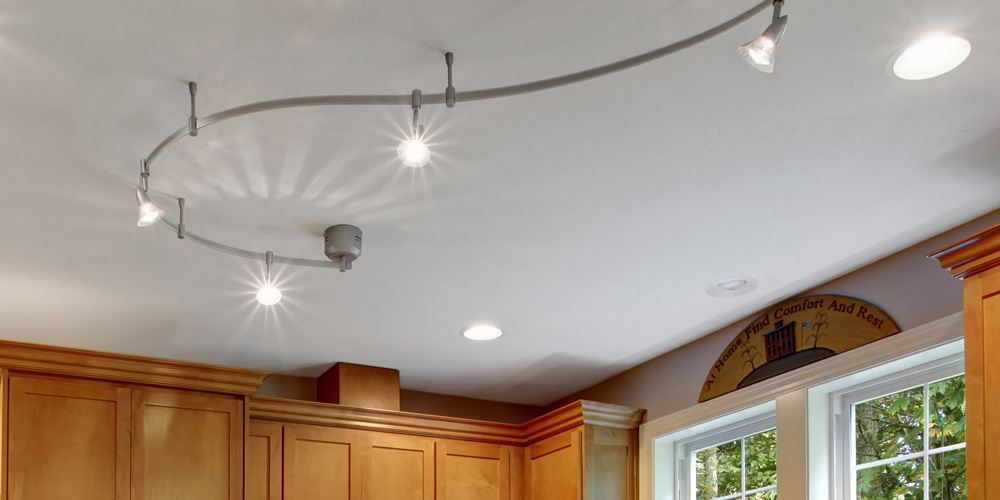
Monorail track lighting systems call for a single monorail fixed to the ceiling using stems. The track fixtures of the system all hang from this single line. Monorail construction is a newer form of track lighting, which allows greater flexibility in track shapes, curves, and flexibility. Some monorail track systems are much more flexible than others depending on the material used in construction. “S” curves and spirals are popular designs for monorail track lighting systems. Standoffs must be installed along the entire length of a monorail track system. These standoffs should be installed every 3 feet and be uniform in length.

Cable track lighting systems include fixtures, and insulated cables that must be secured into a ceiling or wall at each end of the system. This type of track lighting lends itself to more artful or unique systems. Cable systems suspend fixtures between two parallel insulated cables. The tension of the cables enables this system type to suspend fixtures, making this type an ideal option where mounting surfaces are not flat or are otherwise unsuitable for a traditional track. Cable track lighting systems are low voltage.

A standard in traditional track lighting design, step head fixtures have a flat back and can be rotated to illuminate various points in a room.
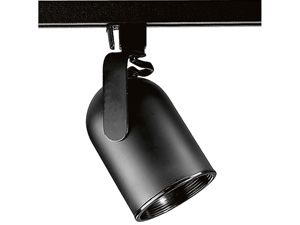
Fixtures with a round back head with a curved sleek appearance.
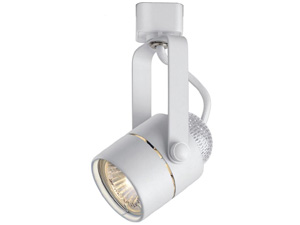
With a partially exposed back, pinhole head fixtures angle towards an industrial aesthetic.
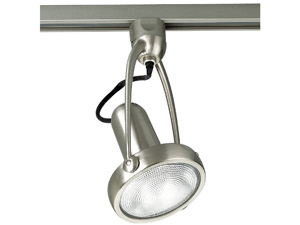
Gimbal head lights have a flat bulb face and can rotate fully from side to side.
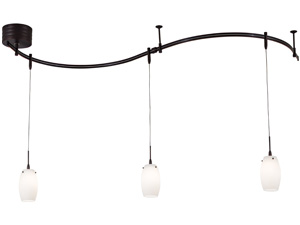
Pendant fixtures hang downwards at varying lengths from the track. Pendants include a rod or cable and fixture housing for one lightbulb.
Contemporary fixtures feature sleek lines and straight-forward styling. Geometric shapes, clean finishes, and modern glass are trademark indicators of the contemporary look.
Transitional lights bridge the gap between traditional and contemporary styles, lifting elements from both new and timeless design for a unique aesthetic. These fixtures may include sleek lines with some decorative ornamentation, elegant curved frames, and light detailing.
Traditional fixtures draw upon time-honored motifs for their design. Traditional lights are highly ornamental, and may recall a vintage European aesthetic. Popular features in traditional design include frosted glass, curved frames, and antiqued bronze finishes.
Popular in country or quaint home design, rustic lighting integrates organic shapes, textures, and weathering for a warm, relaxed look with regained modern appeal.
Craftsman lighting design mimic craftsman home design. Straight, simple lines, sharp angles, and contemporary materials are indicators of the craftsman style. Craftsman lights incorporate artistic hand-made style elements, such as painted finishings and seeded glass.
Contemporary industrial style mimics turn-of-the-century factory design, for a gritty, urban look. These lights use patinaed metals, vintage bulbs, and reclaimed motifs to achieve their signature aesthetic.
Track lighting systems can be used in many interior spaces, and appear best in specific settings:
Close to walls
When directed onto work spaces (kitchen island or counters)
As spotlights for art or other wall decorations
Track lighting should be spaced evenly and in accordance with best installation practices in standard height rooms:
18”-36” from the wall
Taller rooms should position track lighting further from the wall
Shorter rooms should position track lighting closer to the wall
Adapter can be used to achieve a custom track lighting installation
“L” or “T” adapters can link rigid track sections
Flexible or angled adapters can achieve non-linear shapes and custom designs
Purchasing each component of a track light system guarantees compatibility, though compatible components made by different manufacturers are available.
Research and understand your rail and fixture types prior to purchase and installation to avoid compatibility issues.
Consult a professional with installation concerns, as track lighting is one of the more difficult lighting types to install
Do not place fixtures within 6” of fabrics, exposed insulation, or other flammable materials
Most systems provide up to 50,000 hours of continued use.
If you're ready to shop, browse LuxeDecor's stunning selection of track lighting here.



